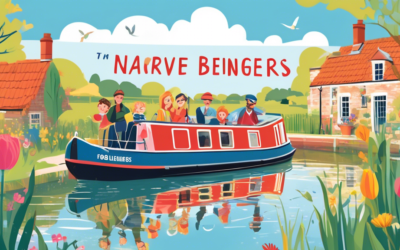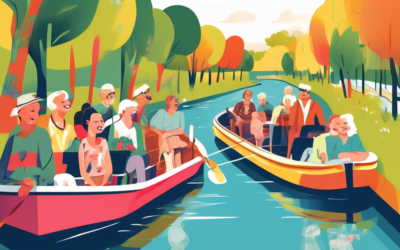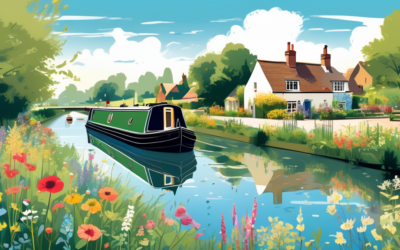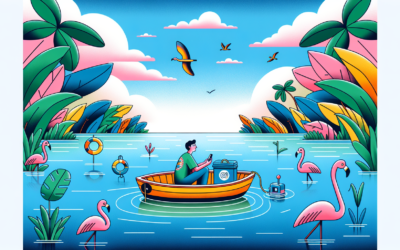Map Reading Essentials for Boaters: Navigating with Confidence
Navigating the waters with confidence is an indispensable skill for boaters, particularly those cruising through the scenic network of canals in the North West of England, including the Four Counties, Cheshire Ring, and Llangollen Canal. Whether you’re a seasoned boater or setting out on your first canal boat hire, understanding the basics of map reading is essential. This guide will arm you with map reading essentials, anecdotes, and tips from experienced boaters to ensure a smooth journey through the picturesque waterways.
A Beginner’s Starting Point: Understanding Canal Maps
Canal maps, also known as charts, are the navigator’s bible. Unlike road maps, canal maps are specifically designed with the boater in mind, offering a watery perspective of your journey. They provide detailed information about canal routes, including lock locations, bridge numbers, and mooring areas. For those exploring the Four Counties, Cheshire Ring, and Llangollen Canal, acquiring a detailed and up-to-date map is the first step toward successful navigation.
Deciphering Symbols and Abbreviations
One of the first tasks for any novice is learning to interpret the symbols and abbreviations found on canal maps. Locks, for instance, are often marked with a straightforward symbol, but understanding the distinction between single and double locks is crucial. Similarly, bridges are numbered for easy identification, which comes in handy when communicating your location in case of an emergency. Additional symbols indicate water points, winding holes (wide areas where boats can turn around), and potential hazards. Familiarizing yourself with these symbols before setting sail will make map reading much more intuitive.
Planning Your Route: Beyond The Basics
With a good grasp of map symbols, the next step in your map-reading journey involves route planning. This includes estimating travel times, which on canals, goes beyond simple distance. The number of locks you’ll encounter, for example, can significantly affect your journey time. Each lock might take about 15-20 minutes to navigate, longer if you’re in a queue with other boats.
A boater named John once shared his experience of cruising the Cheshire Ring, emphasizing the importance of allowing extra time for the unexpected. We planned our journey meticulously, yet what truly prepared us was allowing for those moments of pause—be it a picturesque spot that beckoned a leisurely lunch or an impromptu chat with fellow boaters at a lock. Life on the canal is as much about the journey as the destination, he mused.
Navigational Tips and Tricks
Besides the technical aspects of map reading, several tips and tricks can enhance your navigational skills:
- Use a Guidebook: Supplement your canal map with a detailed guidebook. Many include anecdotes about points of interest and historical sites, especially useful along routes like the Llangollen Canal, renowned for its rich history and stunning landscapes.
- Mark Your Progress: Use a waterproof marker to trace your route on the map. This will help you keep track of your journey and make it easier to locate yourself if you get disoriented.
- Know Your Left From Your Right: It might sound simple, but under the pressure of navigating a narrow canal, it’s easy to mix up directions. Remember, the bow (front) of the boat steers opposite to the turn of the tiller. An old boater’s trick is to tie colored ribbons on the left and right sides of the boat for quick recognition.
- Always Plan for the Next Day: At the end of each day, take the time to plan your route for the next day. Consider lock operating times, potential mooring spots, and essential stops for water and supplies.
Embracing Technology: The Role of Digital Maps
While traditional paper maps remain invaluable, the advent of digital maps and GPS technology offers boaters another layer of navigational aid. Many apps now provide real-time updates on lock statuses, nearest mooring spots, and even crowd-sourced reviews of local amenities. However, experienced boaters caution against over-reliance on technology, advising a blend of both digital and paper maps for the most comprehensive navigation strategy. There’s something irreplaceable about unfolding a canal map on the deck of your boat, tracing your finger along the route, remarked Emma, a seasoned boater on the Llangollen Canal. Yet, I must admit, checking an app for the nearest pub does have its perks! she added with a laugh.
The Art of Slow Travel
Navigating the canals is as much an art as it is a skill. It teaches patience, precision, and the ability to adapt to the unexpected. The slow pace of canal travel invites mindfulness and a deep appreciation for the natural beauty and historical richness of the British waterways. Map reading, in essence, becomes more than just a tool for navigation; it’s a way to connect deeply with the environment, bringing stories, landscapes, and communities into sharper focus.
Final Thoughts
Mastering map reading is a rewarding endeavor that enhances the canal boating experience. Establishing a solid foundation in the basics, supplemented with navigational tips and an openness to learning, will equip you with the confidence to navigate the waterways of the North West of England and beyond. As you embark on your canal adventures, remember that every turn of the canal holds a new story waiting to be discovered, every lock navigated is an achievement, and every map read is a step closer to becoming a seasoned navigator of the waterways.
So gather your maps, plan your route, and set sail into the heart of England’s beautiful canals, embarking on a journey that promises tranquility, discovery, and adventure in equal measure.
Fancy a boat holiday – Check out Floating Holidays fleet for hire!







0 Comments